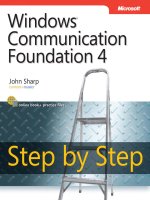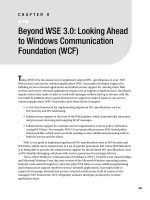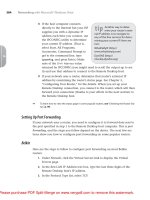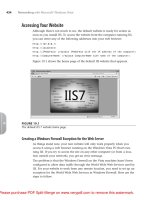1184 microsoft windows identity foundation cookbook
Bạn đang xem bản rút gọn của tài liệu. Xem và tải ngay bản đầy đủ của tài liệu tại đây (19.02 MB, 294 trang )
www.it-ebooks.info
Microsoft Windows
Identity Foundation
Cookbook
Over 30 recipes to master claims-based identity and
access control in .NET applications, using Windows Identity
Foundation, Active Directory Federation Services, and
Azure Access Control Services
Sandeep Chanda
BIRMINGHAM - MUMBAI
www.it-ebooks.info
Microsoft Windows Identity Foundation
Cookbook
Copyright © 2012 Packt Publishing
All rights reserved. No part of this book may be reproduced, stored in a retrieval system, or
transmitted in any form or by any means, without the prior written permission of the publisher,
except in the case of brief quotations embedded in critical articles or reviews.
Every effort has been made in the preparation of this book to ensure the accuracy of the
information presented. However, the information contained in this book is sold without
warranty, either express or implied. Neither the author nor Packt Publishing, and its dealers
and distributors will be held liable for any damages caused or alleged to be caused directly or
indirectly by this book.
Packt Publishing has endeavored to provide trademark information about all of the companies
and products mentioned in this book by the appropriate use of capitals. However, Packt
Publishing cannot guarantee the accuracy of this information.
First published: April 2012
Production Reference: 1170412
Published by Packt Publishing Ltd.
Livery Place
35 Livery Street
Birmingham B3 2PB, UK.
ISBN 978-1-84968-620-4
www.packtpub.com
Cover Image by David Gutierrez ()
www.it-ebooks.info
Credits
Author
Project Coordinator
Sandeep Chanda
Michelle Quadros
Reviewers
Proofreaders
Senthil Kumar
Clyde Jenkins
Pushpendra Singh
Linda Morris
Acquisition Editor
Indexer
Rukshana Khambatta
Development Editor
Hemangini Bari
Graphics
Shreerang Deshpande
Valentina D'Silva
Manu Joseph
Technical Editors
Devdutt Kulkarni
Production Coordinator
Vrinda Amberkar
Arvindkumar Gupta
Cover Work
Arvindkumar Gupta
www.it-ebooks.info
www.it-ebooks.info
Foreword
I still remember sitting down with my brand new copy of Writing Secure Code by Michael
Howard and David LeBlanc. Having moved beyond writing relatively simple intranet web
reports, (before the term "BI" came to embody what at the time we thought was an incredibly
innovative way to display call center metrics for managing credit card operations) I found
myself in a development lead position responsible for building a web portal for managing the
collections process for JP Morgan Chase's auto and home business. The portal interfaced with
a number of internal assets, such as SQL Server, Oracle, and IBM Mainframes via Terminal
3270 emulation, as well as external partners, such as Experian and Equifax.
In addition to the learning curve of moving from Classic Active Server pages to productionworthy .NET Framework 1.1 and ASP.NET Web Services, we were just beginning to dramatically
disrupt the enterprise as a way to minimize the friction between systems while increasing the
reusability of these integration investments. As a fledgling new lead, building the portal to stop
world hunger and to cure cancer (as all the intranet portals promised to do in those days), I
was keenly aware that the solution had to be secure, because after all, "All Input Is Evil", and
working in the financial services industry, no security breach or personal information leak
goes unpunished, no matter how trivial.
For weeks I skimmed through the 600 page volume, incrementally building confidence
that I was doing my due diligence in implementing a trusted subsystem, identifying and
authenticating my users, applying the least privilege, and preventing the SQL injection attacks.
Things were significantly simpler in 2003. All of my users were in Active Directory, and as long
as I didn't need them to do multiple hops, NTLM was just fine, thank you very much. I put a
lot of thought into the roles and proudly remember showing my manager how the new users
would automatically have access to the portal as soon as their account was created (provided
IT assigned them to the right group! J).
Well, it turns out this "Web Services" thing was real, and what they did for the enterprise a
decade ago pales in comparison to how service orientation has transformed the way users
expect to be able to interact with software today. The proliferation of modern web applications
and mobility demand a completely new perspective when designing modern applications.
Whether you are building Web, desktop, or mobile solutions that reside on-premise, on the
cloud, or are a hybrid thereof, identity and access control have never been more important.
www.it-ebooks.info
Whether in the enterprise or consumer space, today's users demand access to your
application from anywhere and at any time. And, for your applications to compete in the
market and provide real value, they must compose a variety of assets, that is public and
private, each of which carry their own requirements for authentication and authorization. In
short, modern applications must be claims-aware.
While the options for federating identity and access control across the public and corporate
assets are both varied and daunting, they also present the tremendous opportunities for
unlocking the potential of your applications in taking advantage of the existing investments
at a global scale. To enable this new breed of applications, Microsoft provides the Windows
Identity Framework (WIF), which aims to simplify working with claims-based security by
providing standardized APIs, templates, and tools that make the process of accessing,
interpreting, and mapping claims tenable.
Initially provided as a standalone framework (previously known as Geneva), WIF is now
included as a part of .NET 4.5, which is in beta at the time of writing this book. The inclusion
of WIF in .NET is not merely a packaging decision, but a clear reflection of the commitment
that Microsoft has made to this powerful security framework.
As such, Sandeep's book couldn't come at a better time.
Careful to begin with easy-to-grasp fundamentals of claims-based security, Sandeep
progresses through the common WIF programming tasks using examples in ASP.NET and WCF
familiar to the most .NET developers, while covering bleeding-edge scenarios including new
features exposed in Windows 8 and securing Windows Metro applications.
This book offers a combination of simple, intermediate, and advanced scenarios, covering
AD FS 2.0 and incorporating web identity providers such as Windows Live ID, Google, Yahoo!,
and Facebook with Azure Service Bus Access Control Service. Also covered are the real-world
scenarios that you are likely to encounter for securing Microsoft SharePoint, SalesForce.com,
and Microsoft Dynamics CRM.
In addition to providing a hands-on pragmatic reference that will be immediately valuable to
your next project, this book is a reflection of Sandeep's real-world experience, successfully
applying these concepts and techniques in the field, the value of which is worth the price of
this book alone.
If you are serious about building claims/identity-aware services and the applications on .NET
Framework, and want to get started today, this book belongs in your library.
Rick G. Garibay
General Manager, CSD Practice Neudesic
Microsoft MVP, Connected Systems Developer
www.it-ebooks.info
About the Author
Sandeep Chanda is a Director of Solutions at Neudesic, a Microsoft National Systems
Integrator and Gold Certified Partner. He has been working on several Microsoft Technologies
(including but not limited to .NET, BizTalk, SharePoint, and Dynamics CRM) for the past seven
years, of which the last couple of years were spent on building claims-aware applications
for leading companies in the Manufacturing and Hospitality domains. He is a technology
enthusiast and a speaker at various corporate events and public webinars. He has authored
several articles on Microsoft Dynamics CRM 4.0 in a popular online developer magazine.
Most recently, he has been involved in evangelizing the aspects of Application Lifecycle
Management and developer collaboration, using Team Foundation Server 11 Beta. He also
spends quite a bit of time travelling and training the different teams on the new features
of .NET Framework 4.5 and Windows 8 Metro application development. Sandeep holds an
MS degree in Software Systems from BITS Pilani, and his areas of interest include Serviceoriented Computing, Pervasive Computing, and Haptic Devices. He occasionally blogs
at and can be reached over email at sandeep.
Currently celebrating a decade of technological innovation, Neudesic was founded in 2002 by
forward-thinking industry veterans Parsa Rohani, Tim Marshall, and Anthony Ferry, who saw
opportunity in the development of Microsoft's .NET platform. Neudesic has since acquired a
deep understanding of Microsoft's entire technology stack. The Microsoft National Systems
Integrator and Gold ISV Partner has leveraged its expertise in Microsoft's various platforms to
become a leading provider of SharePoint, Dynamics CRM, Azure, and mobile solutions.
Through the years, various industry and business publications have recognized Neudesic's
meteoric rise from a small startup with a vision to an established force on a mission. For
the fifth straight year in 2011, Inc. Magazine named Neudesic to its list of America's fastest
growing private companies.
Sandeep is associated with Neudesic India, the company's international presence in India
headed by Ashish Agarwal. Ashish is an alumnus of University of South California, and joined
Neudesic in the early days of its inception and has since led the India team to over 100
successful engagements associating with more than 30 clients.
www.it-ebooks.info
Acknowledgement
The best part about writing a book is working with an awesome team that motivates you to
give it your best. That you are holding this book today is attributed to the phenomenal team
that made it happen.
Thanks to the entire editorial team, especially Rukshana Khambatta, Shreerang Deshpande,
and Michelle Quadros, who managed the project with the meticulous planning and the
coordination. This book would not have happened without Rukshana lending her ears to
my original idea and giving it the shape that it needed to address the target audience,
Shreerang's valuable inputs during the review, and Michelle's patience in coordinating with
me and managing the schedule. An extended thanks to Vrinda Amberkar and Devdutt Kulkarni
for their exhaustive scrutiny of every minute detail of the transcript and bringing out a quality
blueprint for release.
To Rick Garibay, Microsoft Connected Systems MVP and GM CS Practice at Neudesic, for
taking time out from his extremely busy schedule and writing a foreword for this book.
To the reviewers, Senthil Kumar and Pushpendra Singh, for their valuable inputs and
expert feedback.
To Pushpendra Singh, Principal Consultant at Neudesic for his invaluable contribution to
Chapter Four and timely advice in making this project a success.
To the partners at Neudesic, Parsa Rohani, Tim Marshall, Anthony Ferry, and Ashish Agarwal
for creating such a wonderful company with which I am proud to be associated.
To Mickey Williams, David Pallmann, Rick Garibay, David Barkol, Mark Kuperstein, and Suman
Choppala from Neudesic for being a source of inspiration and giving me the courage to write.
To Shaun Cicoria from Microsoft for getting me started on the concepts of claims-based
identity and helping with resources at critical times.
To Mahesh Pesani, Rajasekhar Tonduru, Hemant Joshi, and Rajesh Nair for their friendly tips
on the source code and images in several recipes.
And to my family: my wife Sarita, my daughter Aayushi, and my parents, for letting me spoil
countless of their weekends during the course of writing the book.
www.it-ebooks.info
About the Reviewers
Senthil Kumar is a Software Engineer with three years of experience in the IT industry.
He is currently working as a Software Engineer in Bangalore and works mainly on the
Windows or Client Development technologies and has good working experience in C#, .NET,
Delphi, WinForms, and SQL Server.
He is also a Microsoft Certified Professional (MCP) in ASP.NET. He blogs at
and .
He enjoys learning as much as he can about all the things related to the technologies
to get a well-rounded exposure of technologies that surround him.
Senthil completed his Master of Computer Applications from Christ College (Autonomous),
Bangalore in the year 2009 and is an MCA rank holder.
He is passionate about the Microsoft technologies, especially Windows Phone development.
You can connect with him on Twitter ( on Facebook
( and on his blog (www.ginktage.com).
Pushpendra Singh is a Principal Consultant at Neudesic, a Microsoft National Systems
Integrator and Gold Certified Partner. He is a senior member of Custom Applications
Development Practice at Neudesic and has been working on Microsoft Technologies for the
past 6 years. He has played the multiple roles including that of a Senior Architect on the
enterprise-scale projects spanning several domains. His recent focus has been on building
scalable and future-proof applications using Microsoft .NET Framework 4.0, Windows Azure,
WCF, REST, WIF, WPF, and ASP.NET MVC 3. He spends his free time reading books or playing
outdoor games, such as soccer, volleyball, and cricket.
www.it-ebooks.info
www.PacktPub.com
Support files, eBooks, discount offers, and more
You might want to visit www.PacktPub.com for support files and downloads related to your book.
Did you know that Packt offers eBook versions of every book published, with PDF and ePub files
available? You can upgrade to the eBook version at www.PacktPub.com and as a print book
customer, you are entitled to a discount on the eBook copy. Get in touch with us at service@
packtpub.com for more details.
At www.PacktPub.com, you can also read a collection of free technical articles, sign up for a
range of free newsletters and receive exclusive discounts and offers on Packt books and eBooks.
Do you need instant solutions to your IT questions? PacktLib is Packt's online digital book library.
Here, you can access, read and search across Packt's entire library of books.
Why Subscribe?
ff
Fully searchable across every book published by Packt
ff
Copy and paste, print, and bookmark content
ff
On demand and accessible via web browser
Free Access for Packt account holders
If you have an account with Packt at www.PacktPub.com, you can use this to access PacktLib
today and view nine entirely free books. Simply use your login credentials for immediate access.
Instant Updates on New Packt Books
Get notified! Find out when new books are published by following @PacktEnterprise on Twitter,
or the Packt Enterprise Facebook page.
www.it-ebooks.info
www.it-ebooks.info
www.it-ebooks.info
I would like to dedicate this book to my father, Salil Kumar Chanda.
www.it-ebooks.info
www.it-ebooks.info
Table of Contents
Preface1
Chapter 1: Overview of Claims-based Identity
7
Introduction7
Abstracting identity with claims
8
Designing claims-based tokens using Security Assertion Markup Language 11
Augmenting security with a claims-based architecture
17
Implementing federated security using a Security Token Service
23
Implementing Single Sign-On using claims
29
Implementing Single Sign-Out in a trust realm
33
Configuring certificates for the claims-based applications
34
Chapter 2: Programming with Windows Identity Foundation
37
Chapter 3: Advanced Programming with Windows Identity Foundation
79
Introduction37
Configuring applications for Windows Identity Foundation runtime support
38
Implementing claims in ASP.NET MVC 3 Web Applications
42
Extending the Windows integrated authentication to support claims-based
identity52
Implementing claims-based authentication and authorization in
ASP.NET MVC 3
58
Designing claims-enabled WCF services
68
Implementing WIF Session Mode with a distributed token cache
75
Introduction80
Implementing the claims pipeline
80
Designing a custom Identity Provider Security Token Service (IP-STS)
85
Designing a custom Relying Party Security Token Service (RP-STS)
92
Implementing support for SAML 2.0 tokens
98
www.it-ebooks.info
Table of Contents
Implementing Windows identity impersonation with Claims to Windows
Token Service (c2WTS)
Troubleshooting and monitoring in WIF
110
114
Chapter 4: Cloud-based Identity with Azure Access Control Service
119
Chapter 5: Identity Management with Active Directory
Federation Services
171
Chapter 6: Enterprise Server Interoperability with WIF,
Azure ACS 2.0, and AD FS 2.0
205
Chapter 7: Extension and Future of Windows Identity Foundation
237
Introduction119
Configuring Access Control Service for an ASP.NET MVC 3 relying party
120
Leveraging web-based identity providers such as Windows Live, Google,
and Facebook
131
Designing secure REST services using ACS 2.0 and OAuth
142
Using ACS 2.0 Management Service
155
Securing Windows Phone applications using ACS 2.0
163
Securing iOS applications using ACS 2.0
166
Introduction171
Configuring a federation server
172
Implementing a federation scenario with WIF and AD FS 2.0
185
Implementing a identity delegation
192
Integrating AD FS 2.0 with Azure ACS 2.0
198
Troubleshooting in AD FS 2.0 with debug tracing
201
Introduction205
Implementing claims-based authentication in Microsoft SharePoint
Server 2010
206
Implementing claims-based authentication in Microsoft Dynamics
CRM Server 2011
217
Implementing identity with AD FS 2.0 for the applications hosted on
Windows Azure
223
Integrating AD FS 2.0 with Office 365
230
Implementing Single Sign-On with Salesforce
232
Introduction237
Securing Workflow Services using Workflow Foundation
Security Pack CTP 1
238
Implementing WIF SAML 2.0 Extension CTP
246
Securing Windows 8 Metro applications using Azure ACS 2.0
251
ii
www.it-ebooks.info
Table of Contents
Implementing machine-driven, claims-based access control with
Windows Server 8
Dynamic Access Control and .NET
Framework 4.5
Configuring Federation Services role in Windows Server 8
256
256
256
262
Index267
iii
www.it-ebooks.info
www.it-ebooks.info
Preface
Implementing security as a cross-cutting concern has several challenges. Consequently, the
modern application development and service-oriented computing practices are alluding to
the idea of claims-based identity implementation for access control. Microsoft's Identity and
Access Control paradigm leverages the industry standard open specifications on claims-based
security and provides the tools, the runtime, and the platform support for facilitating the
development of the claims-enabled applications.
This book explores the real world scenarios on building claims-enabled .NET Framework
applications using Windows Identity Foundation (WIF), Active Directory Federation Services 2.0
(AD FS 2.0), and Windows Azure Access Control Services 2.0 (ACS 2.0), the three most widely
used products from Microsoft's Identity and Access Control stack.
Packed with more than 30 hands-on recipes, the book starts with introducing you to the
world of claims-based identity in .NET Framework 4.0, and then moves on to demonstrate the
capabilities of the runtime and the associated SDK. This includes the steps for performing
identity delegation in ASP.NET MVC 3 applications, creating WCF security token services,
extending the runtime to provide support for SAML 2.0 specifications, and using Windows
Azure ACS as a trusted source for implementing access control. Further, the book dives deep
into the relevant support extended in some of the server technologies of the ecosystem
including Microsoft SharePoint 2010, Dynamics CRM 2011 and Sales Force. In addition, it
also features a chapter on the newer capabilities of the runtime including support for claims
in the Windows Server 8 and Windows 8 Metro style applications.
This book provides a mixture of recipes from basic to advance to enable the
professional developers to implement claims-based identity in enterprise-wide scalable
and interoperable applications.
www.it-ebooks.info
Preface
What this book covers
Chapter 1, Overview of Claims-based Identity, introduces readers to the concept of
claims-based identity, provides an overview of the Security Assertion Mark-up Language
(SAML) specification, and gets them ready to start with the rest of the book.
Chapter 2, Programming with Windows Identity Foundation, introduces Windows Identity
Foundation that is a .NET Framework runtime feature for building claims-based applications
using Microsoft's Identity and Access Management paradigm. This chapter will cover aspects
of programming claims in .NET applications using WIF with real world examples.
Chapter 3, Advanced Programming with Windows Identity Foundation, digs deep into the
anatomy of Windows Identity Foundation and cover real world examples on building custom
Security Token Service (STS) and extending the runtime to support SAML 2.0 profiles.
Chapter 4, Cloud-based Identity with Azure Access Control Service, introduces Azure Access
Control Services 2.0 that provides cloud-based identity management solutions based on
Microsoft's Identity and Access Management paradigm. This chapter will cover aspects of
cloud-based authentication services and showcase recipes exploring claims-based identity
with ACS 2.0 in the native mobile applications.
Chapter 5, Identity Management with Active Directory Federation Services, introduces AD
FS 2.0 that provides federation services using the claims-based identity model on Active
Directory users. This chapter covers the aspects of configuring a federation server using
AD FS 2.0 and using it in conjunction with WIF and Azure ACS 2.0 to serve end-to-end security
needs of an enterprise.
Chapter 6, Enterprise Server Interoperability with WIF, Azure ACS 2.0, and AD FS 2.0,
focuses on enabling claims-based identity in some of the popular enterprise servers and cloud
technologies from Microsoft including Microsoft SharePoint Server 2010, Microsoft Dynamics
CRM Server 2011, Windows Azure, and Microsoft Office 365. In addition, it also explores the
steps to provision a seamless Single Sign-On experience in SalesForce with AD FS 2.0.
Chapter 7, Extension and Future of Windows Identity Foundation, provides a glimpse of the
future of claims-based identity with Windows 8 and .NET Framework 4.5. In addition, you will
learn about some of the enhancements in the WIF runtime to provide support for claimsbased identity in Windows Workflow Foundation and enable the developers to leverage the
latest SAML 2.0 specifications for building SP-Lite compliant applications.
2
www.it-ebooks.info
Preface
What you need for this book
A strong foundation in the C# programming language and .NET Framework 4.0 is expected,
along with a good understanding of the authentication and the authorization concepts
(Windows-based and Forms-based) in .NET. In addition, having the following skill sets is desirable:
ff
Application development experience in mobility platforms such as Windows Phone 7
and Apple iPhone.
ff
Administrative knowledge of operating and configuring Windows Server 2008 R2 and
Windows Server 8, Windows Azure Management Portal, Microsoft SharePoint Server
2010, Microsoft Dynamics CRM Server 2011, and Sales Force.
No prior knowledge of the subject is necessary.
Who this book is for
This book is for the professional .NET developer building access control in his applications
using claims-based identity. This book is also an excellent choice for the professionals and the
IT administrators trying to enable Single Sign-On across the applications within the enterprise
and in the cloud spanning interoperable platforms. The book introduces the readers to the
concept of claims-based identity and then walks them through the recipes addressing the
complex authentication and authorization scenarios.
Conventions
In this book, you will find a number of styles of text that distinguish between different kinds of
information. Here are some examples of these styles, and an explanation of their meaning.
Code words in text are shown as follows: "In this recipe, we will find out how a Windows
identity can be abstracted with claims using the System.IdentityModel assembly in
.NET Framework 4.0."
A block of code is set as follows:
using (WindowsClaimSet claims = new WindowsClaimSet(WindowsIdentity.
GetCurrent()))
{
foreach (var claim in claims)
{
Console.WriteLine(string.Format("Claim Type: {0}",
claim.ClaimType));
Console.WriteLine(string.Format("Resource: {0}",
claim.Resource.ToString()));
Console.WriteLine(string.Format("Right: {0}", claim.Right));
Console.WriteLine
("**********************************************");
}
}
3
www.it-ebooks.info
Preface
When we wish to draw your attention to a particular part of a code block, the relevant lines or
items are set in bold:
<!--Commented out by FedUtil-->









